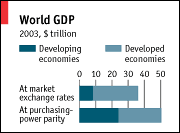|
| ||||||
|
| |
 | |
|
|
HOW big is the world economy? That sounds like a straightforward question. Simply to add up the size of all the world's national economies would seem to be the obvious way to answer it. But how that is done yields radically different results, and therein lies a tale. The most commonly used method is to convert national economic outputs to a single measure, namely the American dollar, using the market exchange rates of all the national currencies. That produces a figure of $36 trillion for 2003. But many professional economists think that it makes much more sense to use what they call purchasing-power parities (PPP), which take account of differences in prices of the same goods between countries, and so tries to measure the real purchasing power of inhabitants in each country, no matter what the world's fluctuating currency markets happen to be doing to exchange rates. Using this method, the world economy last year was worth $50 trillion.
The precise size of the world economy may not matter much from a policy point of view, though a $14 trillion difference is hardly small change. However, which method of measurement is used also affects more important matters: the global rate of growth, the relative size of economies, and the extent of inequality between rich and poor. In these cases, using market exchange rates can produce misleading results and hence stimulate bad policies.
The best reason for not using market exchange rates is that prices tend to be lower in poorer countries, so a dollar of spending there is worth more. Market rates therefore understate their real level of development (see article). Indeed, measured at market rates, developing economies' share of global income has fallen over the past two decades, to less than one quarter. This would back the claims of the anti-globalisation lobby that poor countries are being left behind. Yet measured at PPP, developing economies' share of world income has risen over the same period, to almost half of the total, which gives a more realistic impression.
PPPs are not always appropriate. Trade and capital flows which, unlike the bulk of GDP, are actually transacted at market exchange rates, should be converted at those rates into dollars. And businesses which trade internationally and have to convert revenues and profits to dollars are often more interested in the dollar purchasing power of various national markets than their real level of economic prosperity, so for businessmen the market-exchange-rate measure matters more.
But for government policymakers, this measure can be seriously misleading, and they ought to pay more attention to PPP. One glaring example, to which The Economist drew attention last year, is the analysis of the Intergovernmental Panel on Climate Change. Ian Castles, a former head of the Australian Bureau of Statistics and David Henderson, formerly chief economist of the OECD, have exposed flaws in the IPCC's projections of future emissions of greenhouse gases. The IPCC's forecasts of global output are based on national GDP converted to dollars using market exchange rates. They also bravely assume that most of the gap in average income between rich and poor countries will be closed by the end of this century, even while the rich continue to get richer. Because using market exchange rates overstates the initial gap in average income between rich and poor countries, this results in improbably high projections of GDP growth in developing countries, much faster than has ever been achieved before. As a result, the IPCC's projections of future carbon emissions, on this basis alone, are probably overstated.
The IPCC claims that measuring at PPP or market exchange rates does not affect the economy any more than a switch from degrees Celsius to Fahrenheit alters the temperature. But the analogy is wrong. PPP and market exchange rates, unlike Celsius and Fahrenheit, are measuring different things. That should not be too hard an idea for scientists to grasp.
| Copyright © 2004 The Economist Newspaper and The
Economist Group. All rights reserved. |